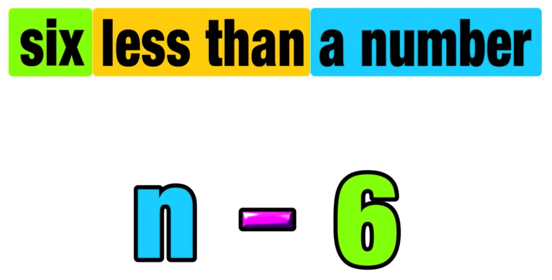Translating Words into Algebraic Expressions
Welcome to this complete guide to translating words into algebraic expressions (also known as algebraic translation), where you will learn how to identify and apply key information, in the form of words and phrases, to accurately translate a given set of words into an algebraic expression involving both numbers and variables.
Why is learning how to translate words into algebraic expressions a crucial skill that every math student must learn? Because it is often the case that math problems are expressed completely in words without any explicit use of numbers, expressions, or equations. In order to solve these types of math word problems, students have to be able to translate words into expressions or equations so they may model and solve such scenarios.
Are you ready to learn everything there is to know about algebraic translation?
The following free Translating Words into Algebraic Expressions lesson guide is a step-by-step tutorial that will teach you how to easily and accurately translate any given word phrase into a mat equation.
How can you translate written expressions into numerical form?
The key skill associated with algebraic translation is being able to rewrite mathematical situations expressed in words as a mathematical expression involving numbers, operations, and variables.
Before we get to actually translating words into algebraic expressions, let's lay some important groundwork!
Tip #1: Expressing Variables
For example, what if we wanted to translate the phrase the sum of seven and five into an expression. It would be pretty easy to translate this phrase into 7 + 5 and your job would be done.
But what if we changed the phrase to the sum of a number and five? How would our numerical expression change? Since a number could represent any value, we have to use a variable (since a variable can represent any value).
In this case, you could translate the sum of a number and five into x + 5 where x represents a number.
When using letters as variables in a math expression or equation, x is the most commonly chosen letter, but you can actually choose any letter to represent an unknown value.
Example A: Translate the phrase ten plus a number into an algebraic expression.
To complete this translation, we can break the given phrase down into three parts:
I: ten ➔ 10
II: plus ➔ +
III: a number ➔ x
Now, you can translate ten into 10, plus into an addition sign, and a number into a variable leaving you with:
ten plus a number ➔ 10 + x
Tip #2: More Than/Less Than
Now, let’s slightly change the words given in Example A as follows:
Example B: Translate the phrase ten more than a number into an algebraic expression.
You probably already know that more than is associated with addition so the sign is not going to change. But what about the order of the terms?
Think about it this way: we have a number (some unknown value) and this phrase represents ten more than whatever that value is. So, in this case, you will start with the variable first and then add ten to it as follows:
ten more than a number ➔ x+ 10
You would be correct to wonder whether or not the order of the terms matters in this example. Technically, it does not because addition is commutative. But what about subtraction, which is not commutative?
See Also: The Commutative Property: Everything You Need to Know
Example C: Translate the phrase six less than a number into an algebraic expression.
Notice again that we are seeing the word than.
You probably already know that less than is associated with subtraction so you already know what sign you will be using.
This phrase represents a value that is six units smaller than whatever our unknown value is. So, to find that number, we would have to take our variable and subtract six from it as follows:
six less than a number ➔ n-6
In cases like Example B and Example C, the second term comes first and the first term comes second (you have to switch the order).
So, we can conclude that than is a switch word, which means that the operator in the middle stays the same, but the first term and the last term are switched. Look out for this relationship when you see the phrase more than or less than in words.
Tip #3: Groupings and Parenthesis
Let’s move onto another example…
Example D: Translate the phrase the difference of three and a number into an algebraic expression.
Translating this phrase into an expression should be pretty straightforward.
Since difference means subtraction, we can easily perform the following algebraic translation:
the difference of three and a number ➔ 3 - p
Now, what if we changed this expression to the difference of three and twice a number plus one
Example D: Translate the phrase the difference of three and twice a number plus one into an algebraic expression.
So, now instead of 3 - p, we have to write the expression as 3 - the entire expression twice a number plus one, which we can call 2p + 1.
Note that you will have to use parenthesis to enclose the entire expression twice a number plus one as follows:
the difference of three and twice a number plus one ➔ 3 - (2p+1)
So, whenever you are performing algebraic translations, you can use parenthesis to separate independent groupings.
Translate Algebraic Expressions Practice
Now that you understand some key elements of translating words into algebraic expressions, you are ready to practice on your own. Go ahead and translate the following words into algebraic expressions on your own and then check the answer key at the end of this post to see how you did!
Practice Problems: Translate each phrase into an algebraic expression.
1.) nine times a number
2.) the sum of a number and twelve
3.) twice a number decreased by eleven
4.) twenty less than a number
5.) half a number plus two
6.) the quotient of five and a number
7.) five times the difference of a number and one
8.) the sum of sixteen and three times a number minus four
Wait! Don’t scroll further until you’re ready to see the answer key.
Answer Key:
1.) nine times a number ➔ 9x
2.) the sum of a number and twelve ➔ n + 12
3.) twice a number decreased by eleven ➔ 2y - 11
4.) twenty less than a number ➔ m - 20
5.) half a number plus two ➔ (x/2) + 2
6.) the quotient of five and a number ➔ 5 ÷ p
7.) five times the difference of a number and one ➔ 5(x-1)
8.) the sum of sixteen and three times a number minus four ➔ 16 + (3y - 4)
How to Translate Algebraic Expressions Video
Are you looking for more help with translating algebraic expressions? Check out our free step-by-step video lesson below:























